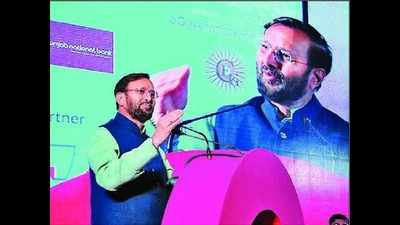- News
- City News
- jaipur News
- Government’s vision document 2022 on education sounds like an election manifesto’
Trending
This story is from September 25, 2018
Government’s vision document 2022 on education sounds like an election manifesto’
Barely two months ahead of the assembly polls, the state higher education department issued a document ‘Higher Education in Rajasthan Vision 2022’ during the higher education and human resource conclave addressed by HRD minister Prakash Javadekar in Jaipur on Monday.

HRD minister Prakash Javadekar at a conclave in the city on Monday
JAIPUR: Barely two months ahead of the assembly polls, the state higher education department issued a document ‘Higher Education in Rajasthan Vision 2022’ during the higher education and human resource conclave addressed by HRD minister Prakash Javadekar in Jaipur on Monday.
Expert says that the vast portion of the document sounds like an election manifesto promising the opening of two new universities, 32 new degree colleges at unserved headquarters, opening 14 new girls’ degree colleges aiming to remove spatial and gender inequity, opening 50 new B.Ed colleges in unserved tehsils, setting up of five new engineering colleges, five new polytechnics by 2022.
State has 186 government colleges. The document says that by the end of 2018 every college will have seminar/meeting room (with audio-visual equipment installed), smart class rooms, smart labs, at least one outdoor sports ground. The funds for setting up above facilities is not mentioned, however, Kiran Maheshwari, state higher education minister has hinted that Bhamashahs (donors) will be approached for developing infrastructure during the conclave.
The documents also talks about some institutional changes which is required for the institutes to move to the next level. Its makes it compulsory for the institutes to be NAAC accredited in four phases. The NAAC accreditation will enable the institutes to participate in several funding schemes. The vision document made the admission that the student teacher ratio is at present 1:65 which is among the highest in country. "By 2020, the student teacher ratio will be 1:20," said the document. This target will not be possible unless the state runs non-stop recruitment drive.
The All India Survey on Higher Education (AISHE) report says that Rajasthan’s gross enrolment ratio was 4% less than the national average with 21.7% in 2017-18 while the country’s national average was 25.8. The survey painted state in poor light in terms of gender parity index. For every 100 boys enrolled in the higher education institutes, it has 91 girls. The national average in the same category was 97 girls against 100 boys.
Expert says that the vast portion of the document sounds like an election manifesto promising the opening of two new universities, 32 new degree colleges at unserved headquarters, opening 14 new girls’ degree colleges aiming to remove spatial and gender inequity, opening 50 new B.Ed colleges in unserved tehsils, setting up of five new engineering colleges, five new polytechnics by 2022.
State has 186 government colleges. The document says that by the end of 2018 every college will have seminar/meeting room (with audio-visual equipment installed), smart class rooms, smart labs, at least one outdoor sports ground. The funds for setting up above facilities is not mentioned, however, Kiran Maheshwari, state higher education minister has hinted that Bhamashahs (donors) will be approached for developing infrastructure during the conclave.
The documents also talks about some institutional changes which is required for the institutes to move to the next level. Its makes it compulsory for the institutes to be NAAC accredited in four phases. The NAAC accreditation will enable the institutes to participate in several funding schemes. The vision document made the admission that the student teacher ratio is at present 1:65 which is among the highest in country. "By 2020, the student teacher ratio will be 1:20," said the document. This target will not be possible unless the state runs non-stop recruitment drive.
The two important proposals which the document says are to have gender atlas of the state through application of remote sensing and GIS techniques. “The digital mapping based on gender will help understand the status of gender at district and block level for the purpose of planning for regional development at micro level. The target set a state wide gender map is 2019," said the document. Yuva Swavlambhan Yojna, a scheme launched for setting up career counselling placement and skill training cell in government colleges. The Yojna will be spread in 10 institutes in 2018 and all Institutes by 2021. Digital libraries and automation of libraries in 50 government colleges every year.
The All India Survey on Higher Education (AISHE) report says that Rajasthan’s gross enrolment ratio was 4% less than the national average with 21.7% in 2017-18 while the country’s national average was 25.8. The survey painted state in poor light in terms of gender parity index. For every 100 boys enrolled in the higher education institutes, it has 91 girls. The national average in the same category was 97 girls against 100 boys.
End of Article
FOLLOW US ON SOCIAL MEDIA










